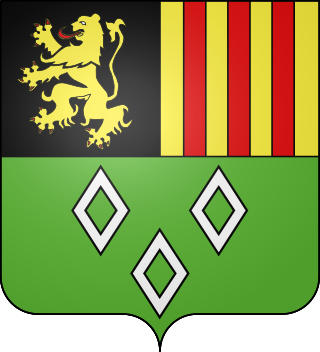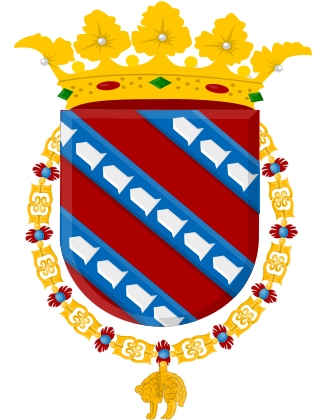
The Lords of Ayseau(x) (sometimes d'Aysia) belonged to an ancient feudal nobility of the Duchy of Brabant. [1] The Lordship was ruled by the House of Gavre, which descended from an illegitimate (later legitimized) offspring of the House of Brabant.

The Lords of Ayseau(x) (sometimes d'Aysia) belonged to an ancient feudal nobility of the Duchy of Brabant. [1] The Lordship was ruled by the House of Gavre, which descended from an illegitimate (later legitimized) offspring of the House of Brabant.
The title was given to the legitimised son of the Duke of Brabant, and belonged for generations to their descendants. Various important noble houses, amongst them the Brant-family and the house of Ghistel took possession of the dominium. In 1454 Philipp, Duke of Brabant proclaimed that Arnould Brant would have a "rente héreditaire sur la Terre de Grobbendoncq." His brother Jean would inherit the benefits of Grobbendoncq in exchange of the lands of Ayseau. [2]
The dominium was later elevated to a Marquisate in 1626 by King Philip IV of Spain for Rasse of Gavre, 1st Marquess of Ayseaux. [3] The marquess of Ayseau took seat in the Second Estate of Brabant. The families were buried in the Church of Ayseau, where their mausoleum can be found.
John III, Duke of Brabant ; (Elisabetha Maria of Huldenberg)
Charles of Gavre, Count of Beaurieu;
married to Honorine, Lady of Ayseau and l'Escatiere.

The House of Hornes was an old and important European noble family, which became extinct in the male line in 1826. The name refers to Horn, a small village in Limburg, located in the Netherlands.

The Marquess of Lede was a Flemish title in use during the Ancien Régime. Lede is a city in Flanders, Belgium.

The House of Ursel is the name of an old Belgian noble family of German origin. The Head of the House is styled as Duke of Ursel, while other members are styled as Count/Countess of Ursel.

A royal bastard is a child of a reigning monarch born out of wedlock. The king might have a child with a mistress, or the legitimacy of a marriage might be questioned for reasons concerning succession.

Luis de Velasco y Velasco, 2nd Count of Salazar, 1st Marquess of Belvedere,, was a Spanish military commander during the French Wars of Religion and the Eighty Years' War.

The de Lalaingfamily is a noble family from the south of Flanders which played an important role in the history of the County of Hainaut and of the Netherlands. The current family belongs to the Belgian nobility.

The House of Lannoy is the name of an old and important Belgian noble family that takes its name from the town of Lannoy in northern France. The name comes from l'Annoy, which means 'the alderwood' in Picard French of Flanders.

Lord of Grobbendonk is a feudal Flemish title originating from Grobbendonk. This title belongs today to the Belgian nobility.

The House of Schetz or Schetz de Grobbendonk, originally House von Schetzenberg is a German Noble House. Most famous is the Flemish branch named Schetz, one of whose members became the first duke of Ursel.

Marquess of Assche is a title belonging to the Belgian nobility, Assche is the old writing of the city of Asse. The Margraveships still stands today and belongs to the House van der Noot. Today the current Marquess of Assche still resides in Belgium.

The Van der Noot family is a Belgian noble family. The title of Count van der Noot is a title created by Emperor Charles VI on 16 May 1716. Since then this title belongs to the Belgian nobility.
Charles Emmanuel Joseph, 1st Prince de Gavre, 4th Marquess of Ayseaux, Count of the Empire was the first Prince de Gavre, created by Emperor Charles VI in 1736. He was the son of Rasse II François of Gavre, 3rd Marquess of Ayseau, and Marie Catherine de Brias.

The House of Glymes was an old Belgian noble family, an illegitimate branch of the House of Reginarid, which ruled the Duchy of Brabant. Glymes or Glimes is a municipality of Incourt. Their descendants of the branch of Grimberghen are styled as the Prince de Grimberghen.

Brimeu is a noble family, some members belonging to the Flemish aristocracy. Brimeux, previously in Flanders, is now in France.

Guy de Brimeu known as the great or Gwijde of Brimeu, was a knight of the Golden Fleece, he was beheaded in Ghent on 3 April 1477.

The House of Hénin is a family of the Belgian high nobility, one of its branches was titled Prince of Chimay. Alliances were made with important Spanish noble families such as house of Borja and the house of Velasco.
The Lords of Corswarem are the heads of the noble house of Corswarem-Looz. The current Dukes of Corswarem are descendants of Lords of Corswarem. The current Duke, Thierry is the 11th Duke of Corswarem-Looz.
Lord Chamberlain of the Archduchess was a ceremonial function at the imperial court of Brussels.

The Lords of Bucquoy were members of the feudal nobility of the Netherlands. Now part of France, the dominium of Bucquoy was inherited by many important families. The House of Longueval moved to Bohemia in circa 1620.
The Marshal of Brabant is a hereditary royal officeholder and chivalric title at the Court of Brabant.